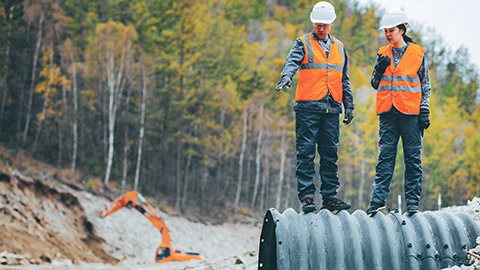We will now take some time to look at legislation. It is important to consider that WHS needs to be compliant with legislation. Having legislation in place ensures it is a mandatory requirement, and should legislation be in a breach, the company or individual may be faced with serious consequences.
The following table illustrates the relationships between Acts, regulations, and codes of practice.
| Acts | Regulations | Codes of Practice |
|---|---|---|
| The Act provides broad responsibilities for workplace health and safety. | The regulations provide legally enforceable requirements for managing specific hazards and risks. | Codes of practice aren’t legally enforceable (but they can be used in court as evidence that legal requirements have not been met). They guide how you can meet the requirements of the Act and Regulations. |
Each state and territory have their own legislation they need to follow. You must familiarise yourself with your own applicable legislation because it is inevitable at some point, you will need to refer to it.
Hot Tip!
Click the link to your own state or territory and pin it to your taskbar for easy access.
WHS legislation
The WHS Act and WHS Regulations provide a framework for health and safety to:
- Secure the health and safety of workers and their workplaces.
- Protect workers and other persons against harm to their health, safety, and welfare through the elimination of risks arising from work by following the principle that workers and other persons should be given the highest level of protection against harm to their health, safety and welfare from hazards and risks arising from work as is reasonably practicable.
- Promote continuous improvement and progressively higher standards of work health and safety.
Fun Fact!
Safe Work Australia developed and a set of model workplace health and safety laws for all implementation by the Commonwealth and the states and territories. However, it is up to each state and territory to evaluate, regulate and enforce the laws if they choose. At the time of writing, all states and territories except Victoria and Western Australia have implemented the model laws.

Environment legislation
Some of the hazards and risks that you will be exposed to in your construction work will be environmental—for example, noise, dust, hazardous substances, weather and so on. A JSEA considers environmental risks as well as safety risks. You will therefore need to be aware of environmental legislation as well as WHS laws.
The environmental legislation relevant to your state or territory includes:
- Victoria: Environment Protection Act 1970 (Vic). Note that in Victoria, the Environment Protection Amendment Act 2018 will come into effect as of 1 July 2021
- New South Wales: Protection of the Environment Operations Act 1997
- Queensland: Environmental Protection Act 1994
- South Australia: Environment Protection Act 1993
- ACT: Environment Protection Act 1997
- Western Australia: Environmental Protection Act 1986
- Tasmania: Environmental Management and Pollution Control Act 1994
- Northern Territory: Waste Management and Pollution Control Act
Each workplace, no matter the chosen field you are in, whether construction, education or beauty, have policies and procedures in place. The policy outlines the responsibilities, and the procedures are the steps that need to be followed. Most policies are paired with a procedure to carry it out effectively.
You must, at all times, follow your workplace policies and procedures. One of the core reasons that organisations have policies and procedures is to ensure legislative compliance. Another reason is to help keep people safe. They also help with:
The policies and procedures which most workplaces have which relate to WHS include:
- Incident reporting
- Workplace safety consultation
- Workplace health, safety and security
- Manual handling
- Driving and use of mobile phones
- Drugs and alcohol
- Mental health and wellbeing
- Emergency management
The following is an example of a typical company policy. The policies are all developed according to the relevant legislative requirements.
WHS sample policy
The <company name> is committed to providing and maintaining a safe and healthy work environment for all staff as it is defined under legislation as:
- employees
- contractors and,
- visitors, including members of the wider community.
By regularly reviewing our processes and health and safety performance, we strive to improve our workplace safety standards and safety culture.
Our goal is to eliminate incidents and injuries in the workplace and create a healthy and positive workplace environment. We are dedicated to supporting both the physical and psychological well-being of staff within our workplaces.
To achieve our health and safety objectives, we aim to:
- Abide by WHS Legislation (including industry Standards and Codes of Practice).
- Consult and communicate with workers regarding Health & Safety issues regularly and wherever possible.
- Meet the requirements of ISO 45001: 2018.
- Enhance our workers' skills, knowledge, and commitment, who include our employees, contractors, and suppliers, through relevant training and professional development.
- Apply Risk Management processes that identify, evaluate and control risks with the specific aim of hazard elimination or risk reduction.
- Provide each employee with appropriate Health & Safety training, equipment, and support to consistently perform their duties safely.
- Support all workers in understanding and dutifully undertaking their Health & Safety duty of care / due diligence responsibilities.
- Set clear safety objectives and targets to support the continuous improvement of our Health & Safety system.
- Be acknowledged as a good corporate citizen concerned for the safety and well-being of all our workers, contractors, and visitors.
The management team are personally dedicated to the consistent improvement of safe working practices at the Company.
All workers, contractors and suppliers associated with our operations must recognise, contribute to, and abide by, commitment to workplace health and safety.
Each company will have their own developed policy; however, how they present it may be different. As an employee, you will have access to the company’s policies and procedures which you will need to understand and follow; you will likely find this in your employee handbook.
Safe work instructions
In building and construction, policies and procedures are often supported by safe work instructions. Safe work instructions are often provided for particular processes which may be deemed high risk. They might also be provided in the form of operating instructions for machinery, tools or equipment. Safe work instructions are one type of administrative control (you will learn more about administrative controls later in this module).

